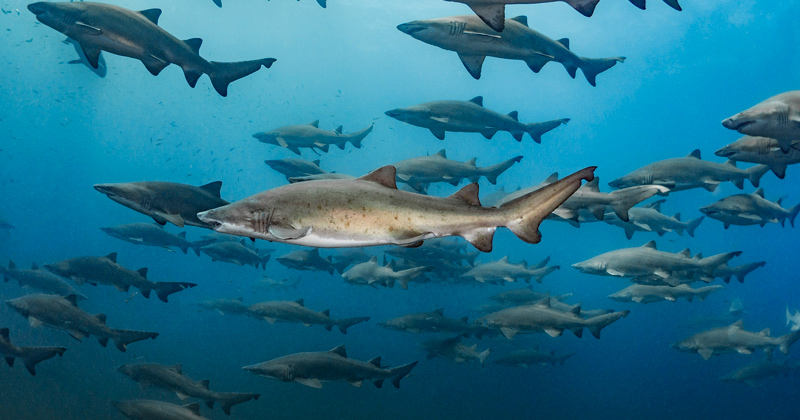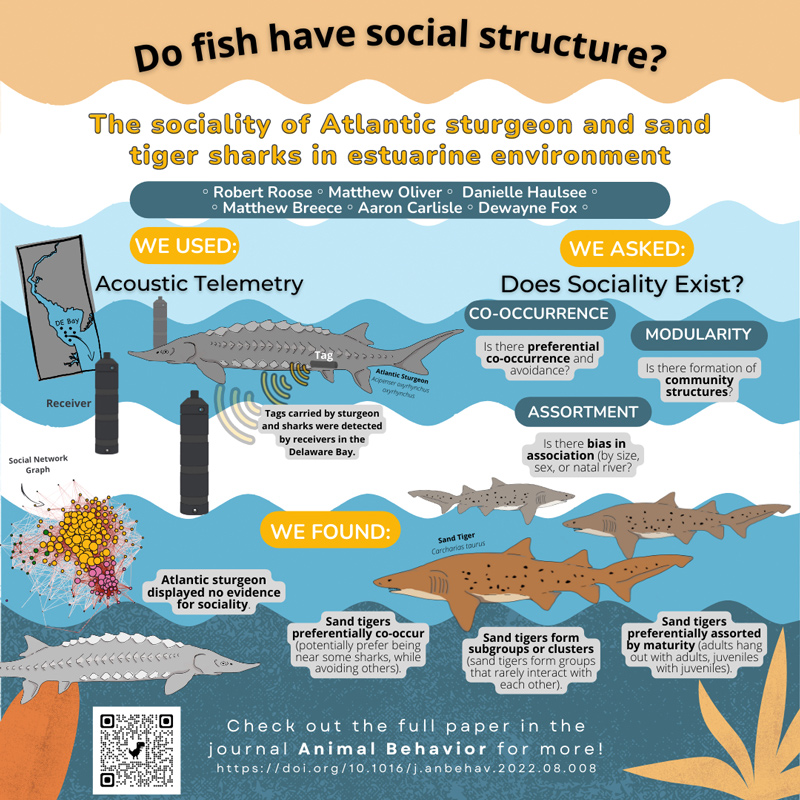


Social sand tiger sharks
Graphic by Danielle Haulsee October 05, 2022
UD study examines the sociality of sand tiger sharks and Atlantic sturgeon in the Delaware Bay
Imagine the Delaware Bay as a high school cafeteria. Like a cafeteria, there can be cliques sitting at certain tables in different areas — such as athletes or people who play in the band — and there can be individuals who don’t really associate with any one group in particular, traveling from table to table. New research from the University of Delaware shows that, much like a high school cafeteria, sand tiger sharks in the Delaware Bay tend to travel in cliques whereas Atlantic sturgeon do not.
The research was recently published in the Journal of Animal Behaviour.
Robert Roose served as the first author on the paper and conducted the research while a master’s level student at UD studying with Matt Oliver, the Patricia and Charles Robertson Distinguished Professor of Marine Science and Policy, who served as a co-author on the paper.
Other co-authors from UD included Matthew Breece, an alumnus and now project scientist who’s doctoral research focused on studying Atlantic sturgeon in the Mid-Atlantic, and Aaron Carlisle, assistant professor in the School of Marine Science and Policy. UD alumna Danielle Haulsee, now a research scientist at Stanford’s Hopkins Marine Station who’s doctoral research focused on sand tiger behavior and migration in the Mid-Atlantic, was also involved. Dewayne Fox, from the Department of Agriculture and Natural Resources at Delaware State University who has spent decades studying these two species in the region, rounded out the team.
Between 2008 and 2013, students and researchers from Delaware State University and the University of Delaware tagged 181 Atlantic sturgeon and 207 sand tiger sharks. This collaborative effort generated an extraordinary amount of acoustic telemetry detections for Atlantic sturgeon and sand tiger sharks and Roose knew he could do an interesting comparative study on the two species.
Acoustic telemetry data is gathered by placing transponders in animals and within an array of acoustic receivers throughout a particular area — in this case, the Delaware Bay. When the fish swim by, their transponders will ping the receivers and reveal their location and their identity.
“When a fish is within range of an acoustic receiver, it will basically tell that receiver, ‘Hi, I’m in your radius at this time,’” Roose said. “It’s more or less a way to track a large number of fish at one time. By compiling the data, we could see about 350 fish at once moving around and swimming in the bay, and determine where they are hanging out at, at the same time.”

This data allowed Roose, who has since gone on to serve as the fisheries research scientist for the Stillaguamish Tribe in Washington State, to see how certain individuals were aggregating with one another, as well as where they liked to hang out geographically in the bay. Because Atlantic sturgeon are an endangered species and sand tiger sharks are a threatened species, knowing where they like to aggregate is important for conservation.
“If you’re trying to protect an endangered species, it’s good to know what habitats they are using and when they’re using them,” Roose said. “One of our videos clearly pointed out their preferred habitat areas.”
Atlantic sturgeon undertake long migrations from the ocean to the river in which they were born, in order to spawn. They are also known to form big aggregations, where fish from different rivers come together and hang out. In his research, Roose wondered if they formed subgroups by natal spawning river when they gathered in those big aggregations.
The data revealed the sociality of the two species — or in the case of Atlantic sturgeon, their lack of sociality.
Using the acoustic telemetry data, the researchers looked for evidence of either species forming preferences — hanging out with friends — and avoiding relationships.
Breaking it down even further, they wanted to determine if the fish preferred to hang out based on maturity state — adults with adults, and young with young — or by sex, which previous studies had shown to be the case.
What they found is that there was no evidence that Atlantic sturgeon formed groups.
“They didn’t preferentially associate, and they didn’t show evidence of preferential avoidance,” Roose said. “So they don’t form subgroups, and they don’t have a significant assortment.”
For sand tiger sharks, however, the opposite effect was shown. There is good evidence for preferred and avoided association, the formation of cliques. Interestingly, they did not group by sex.
“We expected that they would have associated by sex because so many sharks do, so that was a little shocking,” Roose said. “It’s also been shown that when they migrate, they assort by sex. So we expected to see it, but we didn’t see it in the bay.”
The researchers used color coded sociograms to show how the animals associate with one another in the bay. For instance, two fish in the color-coded orange group had a thick line between them which indicated that they spent a lot of time together. The colors help visualize that the Atlantic sturgeon subgroups all mixed together whereas the sand tiger sharp groups have pretty distinct clusters: pinks are in one area, oranges are in a different area, and the greens are in a different area as well. However, it was the network statistics used by Roose that indicate that these patterns are statistically significant.
Roose said that if he had to hazard a guess as to why the sand tiger sharks form distinct social network communities in particular areas, it was probably driven by habitat.
“They’re using different areas of the bay at different times, and that might be the primary driver for that significant modularity which is the subgroup formation,” Roose said. “Still, the big takeaway from this research is that sand tiger sharks seem to have some kind of social background and the Atlantic sturgeon don’t seem to care at all.”
This work builds off previous UD and DSU collaborative efforts studying the habitat selection and behavior of these two species.
“Comparing the differences between habitat use and sociality in two species that display aggregatory behavior and use similar habitats, but that are evolutionarily distinct, allows us to consider how behaviors have evolved differently over time,” Haulsee said.
More work is needed to understand the complexity of shark social behavior but as evidence for sociality in shark species continues to add up, Haulsee said that it, “helps destigmatize these creatures as mindless killing machines.”
For a visual of the sand tiger sharks and Atlantic sturgeon moving throughout the Delaware Bay, check out the YouTube video put together by Roose.
Contact Us
Have a UDaily story idea?
Contact us at ocm@udel.edu
Members of the press
Contact us at 302-831-NEWS or visit the Media Relations website

